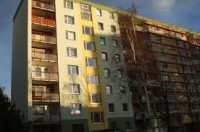White Plains Embraces Property Assessed Clean Energy Program

The White Plains Common Council took action earlier this month to begin a program that would allow commercial entities in the city to apply for long-term loans for energy efficiency improvements on aging buildings.
The program implemented by EIC (Energy Improvement Corporation) in cooperation with NYSERDA, works with local municipalities so the financing of energy improvements can be incorporated into a building’s tax payments. The program is called Property Assessed Clean Energy.
Loan repayment terms are long – up to 20 years and the interest rates are low. The tax charge is not accelerated if the property is sold or foreclosed on. The tax charge stays with the property.
Building owners would apply through EIC, the scope of the work available for that particular property would be determined by NYSERDA through an energy audit and White Plains would have the final sign-off before a loan program is put into place. For small cooperative residential properties the energy audit would probably be free.
Fifteen municipalities in the Hudson Valley have already signed on to the program and six projects in northern Westchester are going through the energy audit process.
The types of energy efficiency improvements include new insulation, windows and other structural components as well as the introduction of renewable energy such as wind and solar.
Beth Smayda, Council president, told the White Plains Examiner she expects White Plains building owners will be able to start applying in March.
Smayda was approached by EIC when she first took office. There were several meetings with EIC attended by Mayor Roach, Councilwoman Milagros Lecuona and Smayda. “We are ready now to roll out the program,” she said.
To qualify for the program buildings must be commercially owned. Businesses and cooperatives that are owned by a corporation can apply. Residential mortgage holders do not qualify at this time, a situation that is in litigation in California because residential mortgage holders Freddie Mac and Fannie Mae do not want the added debt placed on top of the original loan. It is expected this situation will turn as demand for residential energy improvements grow.
The financial requirements for qualification are based on property value. The existing loan can be no greater than 80 percent of the property’s current value and the financing no greater than 10 percent of the value of refurbishment of the benefitted property. The applicant must not have claimed bankruptcy within seven years of the application.
The estimated cost savings of the upgrade must also be greater than the annual tax charge and the applicant must have a three-year history of timely property tax payments.
The existing mortgage holder must consent to the additional loan, a requirement that is not a problem with commercial properties..
According to EIC, older buildings with aging and non-sustainable infrastructure will benefit the most because they burn the most fuel. This cost savings will be determined by NYSERDA and will help determine the depth of the loan. In many cases improvements will result in as much as 20 to 40 percent reduction in utility costs. The deeper the loan the deeper the upgrades.
“This is basically a win, win,” says Smayda. “We reduce our carbon footprint and reliance on fossil fuels, create jobs for people doing the work, and the business incentive will help keep companies in the city.”
While some White Plains municipal buildings like city hall are aging and could use major infrastructure repair, Smayda said because they are not on the tax rolls, they do not comply with the program requirements.
Several local companies that are aware of the program have already come forward, Smayda said.
For more information visit www.energyimprovementcorp.org.
